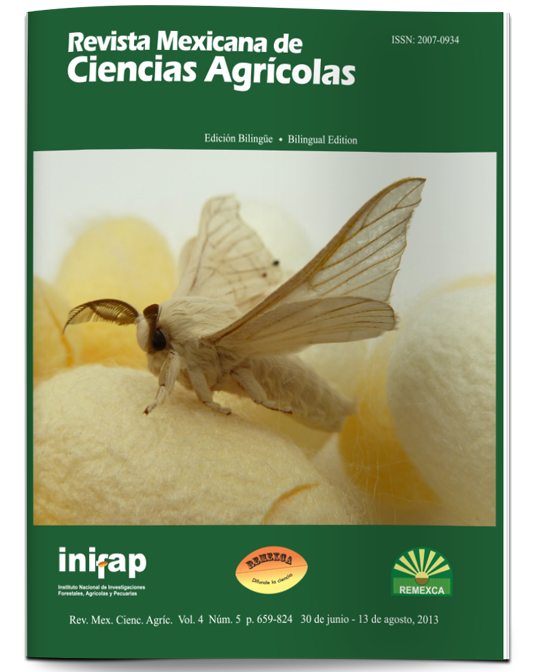Evaluation of the resistance against Phytophthora infestans of wild populations of Solanum lycopersicum var. cerasiforme
DOI:
https://doi.org/10.29312/remexca.v4i5.1173Keywords:
late blight, resistance to disease, tomato, wild speciesAbstract
Late blight caused by Phytophthora infestans (Mont.) de Bary has caused severe losses in the production of tomato (Solanum lycopersicum) in growing areas such as Sinaloa, where losses of up to 100% have been reported. Wild species are a source of disease resistance. Wild populations of Solanum lycopersicum var. cerasiformis were collected in different regions of Mexico, such as the Gulf and Pacific coastal plains, and in intermountain valleys at altitudes around 2000 masl. During the growing seasons of 2008, 2009 and 2010, 19 populations of this variety were evaluated to determine if they have resistance against the pathogen. The Rio Grande variety was used as susceptible control and the LA2533 accession (S. pimpinellifolium) as resistant. We estimated the severity of the disease through the variables: area under the disease progress curve (AUDPC), relative AUDPC, time of onset of symptoms (TAS), rate of disease development (bi) and final evaluation of damage (FE). The results showed variation in the wild populations, from susceptibility to disease resistance. The pathogen resistance response was consistent across the assessment years in which the populations V115, 319, 327 and 330 were noteworthy for presenting the lowest values of AUDPC, AUDPCr, bi and FE, similar to those of LA2533; also, the symptoms appeared 10 days later than in all other populations (longer TAS). The Río Grande control showed considerable damage in all evaluations, up to 100% damage to the plant. These four populations are established as sources of late blight resistance in breeding programs.
Downloads
Downloads
Published
How to Cite
Issue
Section
License
The authors who publish in Revista Mexicana de Ciencias Agrícolas accept the following conditions:
In accordance with copyright laws, Revista Mexicana de Ciencias Agrícolas recognizes and respects the authors’ moral right and ownership of property rights which will be transferred to the journal for dissemination in open access. Invariably, all the authors have to sign a letter of transfer of property rights and of originality of the article to Instituto Nacional de Investigaciones Forestales, Agrícolas y Pecuarias (INIFAP) [National Institute of Forestry, Agricultural and Livestock Research]. The author(s) must pay a fee for the reception of articles before proceeding to editorial review.
All the texts published by Revista Mexicana de Ciencias Agrícolas —with no exception— are distributed under a Creative Commons License Attribution-NonCommercial 4.0 International (CC BY-NC 4.0), which allows third parties to use the publication as long as the work’s authorship and its first publication in this journal are mentioned.
The author(s) can enter into independent and additional contractual agreements for the nonexclusive distribution of the version of the article published in Revista Mexicana de Ciencias Agrícolas (for example include it into an institutional repository or publish it in a book) as long as it is clearly and explicitly indicated that the work was published for the first time in Revista Mexicana de Ciencias Agrícolas.
For all the above, the authors shall send the Letter-transfer of Property Rights for the first publication duly filled in and signed by the author(s). This form must be sent as a PDF file to: revista_atm@yahoo.com.mx; cienciasagricola@inifap.gob.mx; remexca2017@gmail.
This work is licensed under a Creative Commons Attribution-Noncommercial 4.0 International license.



